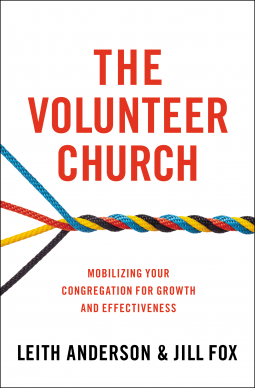
The Volunteer Church
Mobilizing Your Congregation for Growth and Effectiveness
by Leith Anderson, Jill Fox
This title was previously available on NetGalley and is now archived.
Send NetGalley books directly to your Kindle or Kindle app
1
To read on a Kindle or Kindle app, please add kindle@netgalley.com as an approved email address to receive files in your Amazon account. Click here for step-by-step instructions.
2
Also find your Kindle email address within your Amazon account, and enter it here.
Pub Date Aug 04 2015 | Archive Date Aug 22 2017
Zondervan Academic | Zondervan
Description
Working with volunteers can be a rewarding and exciting experience—for them as well as for those who recruit, train, and maintain their services. However, if church leaders are honest, they know there are times that it can be frustrating. They know that volunteers are essential, vital to creating growth and new ministries, and are the key to introducing youth and children to Jesus Christ. They have the welcoming smiles at the door, they serve the food, pray for needs, stuff bulletins, organize missions trips, and on and on. If they want to see their church grow, it must be a volunteering church, a church that runs on volunteers.
The Volunteer Church was developed out of the ministry of Leith Anderson at Wooddale Church in Eden Prairie, Minnesota, where a vital and vibrant volunteer program boasting 4,000 participants grew under the leadership of Jill Fox. The principles and training have been applied in churches of all sizes and denominations in seminar settings across the country as well as at Wooddale Church.
In The Volunteer Church, leaders will
- Learn how to effectively recruit and train volunteers
- Discover how to build sustainable, long-lasting ministries led by volunteers
- Find methods for encouraging and maintaining your volunteers for success
- Know how to build teams of volunteers
- Understand how to find the right service that fits a willing volunteer
If you lead a church and are exhausted by the lack of volunteer help, or if you are a volunteer and dream of adding numbers to your team, this book is for you. If you are on a church staff and know that a new ministry is needed but volunteers and training are required to make it happen, here you will find the resources to recruit, inspire, train, and maintain the church's most vital workforce.
Available Editions
| EDITION | Paperback |
| ISBN | 9780310519157 |
| PRICE | $14.99 (USD) |
Average rating from 13 members
Featured Reviews
 John G, Reviewer
John G, Reviewer
A church without volunteers is an unhealthy church, because the act of volunteering is an expression of worship, it serves people, and it builds relationships. Churches are among the few organizations where the same people are the owners, the funders, the staff, and the customers, according to Leith Anderson and Jill Fox in their book The Volunteer Church: Mobilizing Your Congregation for Growth and Effectiveness.
Part 1 of the book addresses the issues involved in building a volunteer culture, Part 2 discusses ways of recruiting volunteers, and Part 3 covers volunteer training and care. The best method of recruiting volunteers is said to be using other volunteers. Happy volunteers are keen to recruit others, so one of the key ways of maximising recruitment is to take good care of the volunteers you already have.
In addition to providing the theory, the authors provide some useful practical tools. Appendix 1 provides a training plan for staff and those who lead volunteers, covering 5 key steps of volunteer development: recruiting, training, building the team, appreciating and celebrating, and empowering. Appendix 2 provides an outline for a personal Volunteer Development Plan.
I am not a big fan of the distinctions large churches tend to make between “staff” and “volunteers” which tend to assume that staff have the skills and volunteers are unskilled. Nevertheless, church staff are usually the ones responsible for making sure the ministry gets done, and in my opinion this book provides some useful ideas to help with recruiting, organising, deploying and maintaining lay ministry teams.
 Kyle R, Reviewer
Kyle R, Reviewer
This book is well written and not a difficult read. While nothing in it is groundbreaking, it does offer good points for identifying specific individual spiritual gifts, as well as the best ways to utilize volunteers in your church. A church in itself is primarily composed of volunteers that help it survive and thrive. Seeking out and retaining volunteers in your church can be very difficult, but this book discusses ways to avoid pitfalls and burnout. I would recommend it to church pastors, worship leaders, youth and children pastors, and of course volunteer leaders. I received this as a free ARC from Zondervan on NetGalley in exchange for an honest review.
 Conrade Y, Reviewer
Conrade Y, Reviewer
Every member is a servant in the Kingdom of God. For the Church is not a building made of bricks and stones. It is a Body of Christ made of people serving God and one another in the love of Christ. Volunteerism is in. Compulsory work is out. This is particularly so in a ministry that requires us to put our faith into action. If there is any group of people who deserves more encouragement and praise, it would be the group of people who willingly offers to serve at their own time and own resources. Weekly, they work without official pay. They do their best despite not having the best tools or training. In fact, the best form of leadership development is to increase the level of volunteerism in any organization. A Church grows not on the basis of attendance numbers but volunteer numbers. The challenge for any church is not only to encourage the volunteer numbers, but to increase the cheer among all. This book is written for three groups of people.
1) For leaders exhausted by lack of volunteers 2) For volunteers wanting to have more to join them 3) For ministry staff wanting to train and to cultivate a culture of volunteerism
With that, the authors want to:
- Share effective recruitment and training tips - Help build a sustainable culture of volunteerism - Find ways to encourage and motivate the existing volunteers - Ways to build volunteer teams - Helping to find the right fit between volunteers and ministries
Leith Anderson is President of the National Association of Evangelicals, and have degrees from Denver Seminary and Fuller Theological Seminary. Jill Fox is Pastor of Wooddale Church and a graduate of Bethel Seminary.
In Part One, Anderson and Fox touch on what it takes to build a volunteer culture. Their basic assumption is that volunteers are always ready to serve. In fact, they "want" to serve. This helps put any anxiety to rest. It also gives our relationships the benefit of the doubt without needing to be judgmental about it. Like a good physician, the first step is not about prescription, but in asking the right diagnostic questions. Encouraging volunteerism is about genuine interest in the well-being of the volunteer rather than the job at hand. Find a good fit in terms of asking "Tell me more about yourself." Help one another discover the gifts. We learn about how to respond to people who said no. Often the problem is not whether the people are willing, but whether we are serious about the volunteer recruitment in the first place. Like a marriage, people don't say yes just to one proposal without having a history of dating, knowing, and relating to that person. Churches can only thrive with a large volunteer base. Thus, we need to learn to do more asking. We need to go back to Jesus' ministry as a servant. So important is the recruitment of volunteers that the Church leadership needs to support volunteerism all the way. Volunteering is discipleship at its core. The Church is not the pastors' or the board's. Leaders lead by example. Volunteers follow suit. With ASK, AFFIRM, ADVOCATE, ELEVATE, RESOURCE, and PRIORITIZE, we build a volunteer culture. Key to this is to have an experienced volunteer to create an "all-hands-on-deck" culture. Training needs to be all year round. Leaders need encouragement and celebrations are big opportunities to do just that.
Part Two of the book deals with "Recruiting Volunteers." Here is where things get exciting as the rubber hits the road. Anderson and Fox show us that one of the best ways is to let volunteers recruit other volunteers. Like discipleship, it is an opportunity to spread the spirit of joy in volunteering one's time and gifts for the benefit of the community. The very first step when we need volunteers is to empower the existing pool of volunteers to do the same. Not only are there greater number of recruiters, they would begin to understand the challenges of recruitment. It is exciting to see how ideas flow quickly. Give volunteers a place to easily find information about the volunteer positions. Have a ministry tour. Print out job descriptions. Have volunteers to meet with prospective volunteers. What I find most helpful is the way the authors put the volunteers' interest before the task. Being task oriented can sometimes be a stumbling block, especially when individuals feel they are simply a means to an end. This means finding the right fit, discovering spiritual gifts, and sometimes, learning to do the best even when there is no perfect match.
Part Three is about sustaining, maintaining, training, and caring for the volunteer base. It is all about support. It is about trusting that they would do their best. It is about communications and teamwork. One very helpful tip is the idea of "volunteer teams" where people who serve work as a team. The benefits are many. From self-recruitment of volunteers to greater retention, people will be more willing to run the long haul and not easily give up. In fact, when volunteer base shrinks, it is a sign of teams becoming discouraged or have lost sense of their direction and purpose of serving. Praying for the service teams remain a key priority for the Church.
So What?
==========
Many people often see church attendance numbers as a measure of Church health. This is not an accurate measurement. In fact, if forced to put a number to it, I would prefer to measure Church health based on the volunteer numbers rather than the attendance chart. A healthy Church is a volunteering Church. At the heart of any volunteer movement is the art of discipleship. As a leader who has a vision, one needs to begin with the one willing person. Then pray. Together, approach others to do the same, seeking the interest of others more than our desire to simply recruit volunteers. Getting the job done is important, but caring for the volunteers is even more important. There is no point in getting one volunteer today and losing another tomorrow. It will be like a revolving door where one serves on the basis of obligation.
We need to equip individuals not only with skills to serve but also with the heart to want to serve. The single biggest point in this book is that volunteers are raring to serve. It is just that we rarely have individuals who would play the role of encourager and carer for such people. This book is poised to be one of the most important books with regards to creating a culture of service and empowering individual members to serve. When the Church have members learning to serve one another, we have a vibrant community constantly been trained to serve beyond Sundays; beyond Church people; and to be witnesses to the world. Leaders need to read this book!
Rating: 5 stars of 5.
conrade This book is provided to me courtesy of Zondervan Academic and NetGalley in exchange for an honest review. All opinions offered above are mine unless otherwise stated or implied.
Readers who liked this book also liked:
Harold Earls, IV; Rachel Earls
Biographies & Memoirs, Parenting, Families, Relationships
Jefferson Bethke; Jon Tyson
Christian, Parenting & Families, Religion & Spirituality
Amy Quick Parrish
Novellas & Short Stories, Romance, Women's Fiction


















